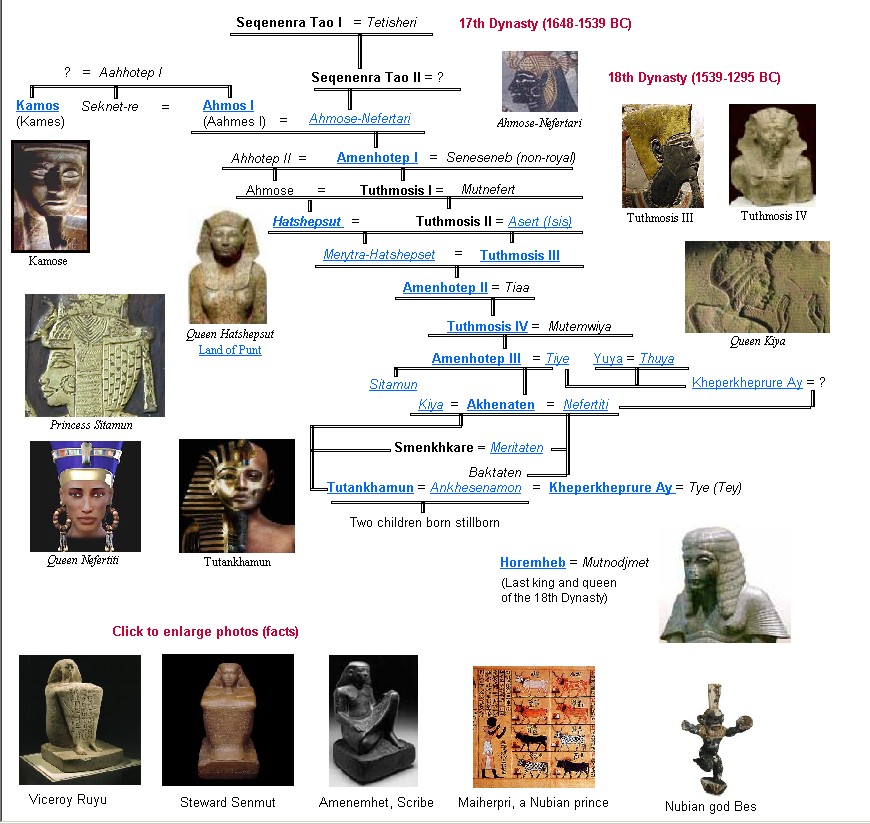
|
|
| VIP News |
Family Tree of Seqenenra Tao I -- 17th & 18th Dynasties
|
| |

Egyptologist Petrie wrote: "His [Seqenenra] wife Aahhotep was one of the great queens of Egyptian history, important as the historic link of the dynasties, and revered along with her still more celebrated and honored daughter Nefertari. We have already noticed how her son Aahmes (so described on Edfu stele), was of the ordinary Egyptian complexion, while her daughter Nefertari, was black. As Seqenenra was Berber, Nefertari might be three-quarters black; while Aahmes, if son of an Egyptian, thus accounting for the difference. The age of Aahmes at his accession, after the insignificant reigns of his brothers, shows that he was the son of a first husband, implying that Aahhotep first married an Egyptian, and secondly, Seqenenra. The reign of Kames before Aahmes shows that he was the elder brother. And the presence of Sekhentnebra between Aahmes and Kames (tomb of Khabekht) shows that he was another brother, who probably reigned briefly between them." (Petrie, A History of Egypt, 1896)
X-raying the Pharaohs:
The authors of X-raying the Pharaohs, (1973) are James E. Harris director of the expedition to x-ray the pharaohs, professor of dentistry and chairman of the Department of Orthodontics at the University of Michigan; and Kent R. Weeks, an American Egyptologist and member of the expedition, is associate professor and chairman of the Department of Anthropology at The American University in Cairo wrote:
Seqenenra Tao: "His entire lower facial complex, in fact, is so different from other pharaohs that he could be fitted more easily into the series of Nubian and Old Kingdom Giza skulls than into that of later Egyptian kings. Various scholars in the past have proposed a Nubian--that is, non-Egyptian--origin for Seqenenra and his family, and his facial features suggest this might indeed be true. If it is, the history of the family that reputedly drove the Hyksos from Egypt, and the history of the Seventeenth Dynasty, stand in need of considerable re-examination".
Written in the book X-raying the Pharaohs states that Donald Redford, a modern Canadian Egyptologist. . . . "believes Hatshepsut´s attainment of the throne represents the final attempt in the Eighteenth Dynasty to establish a strong matrairchate in Egypt. He cites the unusual importance of earlier queens in this period --Tetisheri, Ahhotep I, Ahmose-Nefertari--as evidence of such a tendency, and here suggest that the influences for such a matriarchally determined order of succession might have come from Nubia. The possibility that the rulers of the Seventeenth Dynasty were themselves at least part Nubian".
|
Black/White Alliances; by John Henrik Clarke
We have been hospitable to strangers—nearly always to the wrong strangers! Nearly all of our relationships with non-African people began with a dinner invitation. More than anyone else in the world we repeatedly invited our future conquerors to dinne...
|
|
Akhenaton (1375-1358 B.C.)
1300 years before Christ, he preached and lived a gospel of perfect love, brotherhood, and truth. 2000 years before Mohammed, he taught the doctrine of the "One God." 3000 years before Darwin, he sensed the unity that runs through all living things....
|
|
Cleopatra VII (69-30 B.C.)
Cleopatra was pictured as a distinct African woman, dark in color. Born in 69 B.C., Cleopatra came to the throne, when she was 18 years old.
...
|
|
The Passing of Patrice Lumumba; by John Henrik Clarke (1961)
Lumumba was and is still being extolled this "best son of Africa," this "Lincoln of the Congo," this "Black Messiah," whose struggle was made noble by his unswerving demand for centralism against all forms of Balkanization and rendered heroic by his...
|
|
L´homme qui partagea le dernier repas de Moumié.
"Quand les jeunes Africains créaient l`histoire" L`ouvrage de Jean Martin Tchaptchet est aussi une remarquable galerie de portraits de Camerounais de sa génération, saisis tels qu`ils ont été dans leur jeunesse....
|
|
Les visages ont vieillis par Simon Njami, Cameroun
Quelque chose, quelque part, demeure. Et même si plus personne, jamais, ne courra vers moi, sous le soleil, les bras emplis de fleurs, même si ne persiste plus que le souvenir du souvenir, il reste une trace, un sillon. Cette force de dire non, malgr...
|
|
|
|
| |
|
|
|
|
|
|